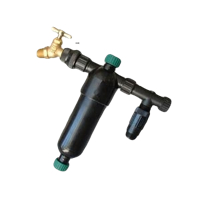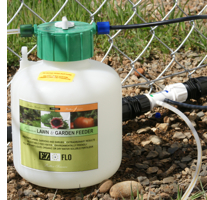Fertilizing Made Simple with Drip Irrigation
Fertigation is the application of fertilizers, soil amendments, or other water-soluble products through an irrigation system. In an effort to maintain healthy plants, most growers occasionally enlist the aid of fertilizers into their normal gardening routine. Fertilizers are added to soil to supply or supplement any number of nutrients to plants as desired. Most plants need nutrients such as nitrogen, phosphorus, potassium, calcium, magnesium, and sulphur. Unless these main macronutrients and any other micronutrients are present in the soil, plants would only receive carbon, hydrogen and oxygen from water and carbon dioxide in the air. By utilizing fertilizers, most growers can conservatively estimate a 30 to 50 percent increase in crop yields in addition to an increase in the overall health of the plants.
Fortunately for drip irrigation users, fertilizer injectors are readily available which make the process of applying fertilizers to plants almost effortless. In a typical drip irrigation system, water is efficiently supplied to the plants utilizing tubing and drip emitters. By utilizing this same delivery system, these injectors are able to apply fertilizers exactly where they are needed, at the plant's root zone. No additional water or time is needed to fertilize since the system operates as part of the normal watering schedule as determined by the user.
 Fertilizer injectors are typically installed as part of a drip irrigation head assembly which, in order, consists of a backflow preventer, filter and pressure regulator. Smaller injector units can be installed between the backflow preventer and the filter. For larger injector units, an adapter is installed instead, with tubing running between the adapter and a main holding tank. When the water supply is turned on, a small amount of water is diverted from the main stream of water flowing through the unit or adapter and forced into the top of the fertilizer tank. A slight pressure differential is created between the inlet and outlet of the tank, thereby drawing the fertilizer out of the tank and back into the main water stream. The water coming into the tank is lighter than the fertilizer, and therefore floats on top. The fertilizer is drawn out of the tank from the bottom, making the injection rate constant from start to finish.
Fertilizer injectors are typically installed as part of a drip irrigation head assembly which, in order, consists of a backflow preventer, filter and pressure regulator. Smaller injector units can be installed between the backflow preventer and the filter. For larger injector units, an adapter is installed instead, with tubing running between the adapter and a main holding tank. When the water supply is turned on, a small amount of water is diverted from the main stream of water flowing through the unit or adapter and forced into the top of the fertilizer tank. A slight pressure differential is created between the inlet and outlet of the tank, thereby drawing the fertilizer out of the tank and back into the main water stream. The water coming into the tank is lighter than the fertilizer, and therefore floats on top. The fertilizer is drawn out of the tank from the bottom, making the injection rate constant from start to finish.
Most fertilizer injectors cannot be subjected to constant pressure, so the unit or adapter will need to be installed after a valve or timer. Some constant pressure units are available, and can be installed before a valve or timer. These types are desirable especially in multi zone systems eliminating the need for a separate fertilizing unit for each zone.

If a colorless fertilizer is used, you will not be able to visually determine when all the fertilizer in the tank is gone since water is constantly cycled through the tank. Add a few drops of food coloring to the clear fertilizer, and once the tank is free of color, you'll know all the fertilizer has been distributed.
The backflow preventer is an important part of the system as it will prevent any fertilizing agent from inadvertently traveling back into any drinkable water supply. Filling a fertilizer injector is usually accomplished by unscrewing a fill cap, emptying any water inside the unit, and refilling the unit with undiluted fertilizer. The fertilizer can be any 100% water-soluble agent in liquid or dry (granular) form. This is important to prevent clogging the drip emitters.
The feed ratio refers to the rate at which the fertilizer is mixed with water. Unlike larger injector units with adjustable feed ratio mechanisms, most smaller units are categorized as proportioning injectors whereby the injection rate of the fertilizer is proportional to the water discharge rate and cannot be adjusted.
Fertilizer injectors made primarily for drip irrigation systems have no moving parts, require no maintenance other than occasional refilling, can be easily installed, and are very durable. Since they are also relatively inexpensive and can save users both time and money, more and more gardeners are adding fertilizer injectors to their already worry-free drip irrigation systems.
Happy gardening!